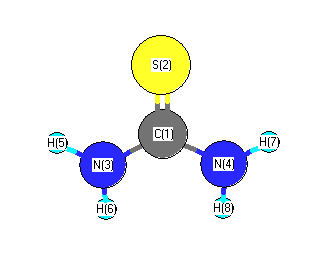Vibrational Frequencies calculated at SVWN/aug-cc-pVDZ
| Mode Number |
Symmetry |
Frequency
(cm-1) |
Scaled Frequency
(cm-1) |
IR Intensities
(km mol-1) |
Raman Act
(Å4/u) |
Dep P |
Dep U |
|---|
| 1 |
A |
3616 |
3589 |
29.02 |
|
|
|
| 2 |
A |
3477 |
3450 |
9.58 |
|
|
|
| 3 |
A |
1560 |
1548 |
132.76 |
|
|
|
| 4 |
A |
1381 |
1371 |
239.84 |
|
|
|
| 5 |
A |
1045 |
1037 |
22.61 |
|
|
|
| 6 |
A |
772 |
766 |
10.11 |
|
|
|
| 7 |
A |
449 |
445 |
0.61 |
|
|
|
| 8 |
A |
435 |
432 |
4.68 |
|
|
|
| 9 |
A |
214 |
212 |
70.22 |
|
|
|
| 10 |
B |
3615 |
3588 |
71.56 |
|
|
|
| 11 |
B |
3466 |
3440 |
45.46 |
|
|
|
| 12 |
B |
1564 |
1552 |
322.53 |
|
|
|
| 13 |
B |
1419 |
1408 |
5.61 |
|
|
|
| 14 |
B |
997 |
989 |
11.94 |
|
|
|
| 15 |
B |
619 |
614 |
0.66 |
|
|
|
| 16 |
B |
576 |
572 |
34.04 |
|
|
|
| 17 |
B |
384 |
381 |
3.12 |
|
|
|
| 18 |
B |
322 |
319 |
326.90 |
|
|
|
Unscaled Zero Point Vibrational Energy (zpe) 12954.7 cm
-1
Scaled (by 0.9924) Zero Point Vibrational Energy (zpe) 12856.2 cm
-1
See section
III.C.1 List or set vibrational scaling factors
to change the scale factors used here.
See section
III.C.2
Calculate a vibrational scaling factor for a given set of molecules
to determine the least squares best scaling factor.
Charges, Dipole, Quadrupole and Polarizability
Charges from optimized geometry at SVWN/aug-cc-pVDZ
Charges (e)
| Number |
Element |
Mulliken |
CHELPG |
AIM |
ESP |
| 1 |
C |
0.331 |
|
|
|
| 2 |
S |
-0.253 |
|
|
|
| 3 |
N |
0.063 |
|
|
|
| 4 |
N |
0.063 |
|
|
|
| 5 |
H |
0.016 |
|
|
|
| 6 |
H |
-0.119 |
|
|
|
| 7 |
H |
0.016 |
|
|
|
| 8 |
H |
-0.119 |
|
|
|
Electric dipole moments
Electric dipole components in Debye
(What's a Debye? See section
VII.A.3)
| |
x |
y |
z |
Total |
| |
0.000 |
0.000 |
-5.084 |
5.084 |
| CHELPG |
|
|
|
|
| AIM |
|
|
|
|
| ESP |
|
|
|
|
Electric Quadrupole moment
Quadrupole components in D Å
| Primitive |
|---|
| | x | y | z |
|---|
| x |
-35.212 |
1.649 |
0.000 |
| y |
1.649 |
-26.015 |
0.000 |
| z |
0.000 |
0.000 |
-29.110 |
|
| Traceless |
|---|
| | x | y | z |
|---|
| x |
-7.650 |
1.649 |
0.000 |
| y |
1.649 |
6.146 |
0.000 |
| z |
0.000 |
0.000 |
1.504 |
|
| Polar |
|---|
| 3z2-r2 | 3.008 |
|---|
| x2-y2 | -9.197 |
|---|
| xy | 1.649 |
|---|
| xz | 0.000 |
|---|
| yz | 0.000 |
|---|
|
Polarizabilities
Components of the polarizability tensor.
Units are
Å
3 (Angstrom cubed)
Change units.
| |
x |
y |
z |
| x |
6.083 |
0.102 |
0.000 |
| y |
0.102 |
9.110 |
0.000 |
| z |
0.000 |
0.000 |
11.387 |
<r2> (average value of r
2) Å
2
| <r2> |
0.000 |
| (<r2>)1/2 |
0.000 |
